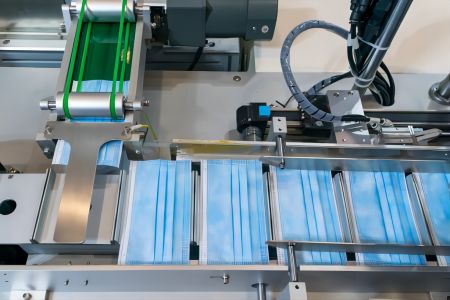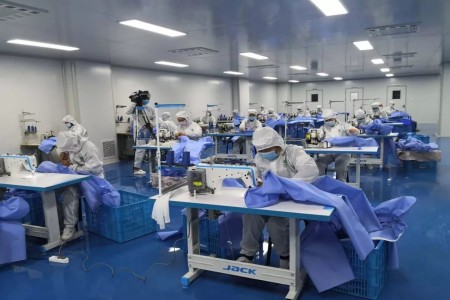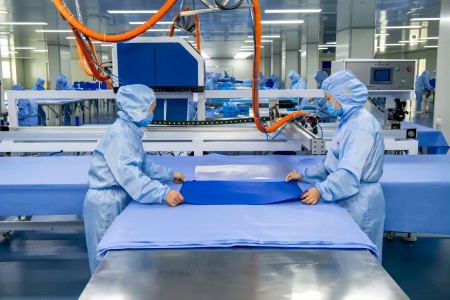2023/6/16

The Role of Scrub Suits in Infection Prevention and Control Measures
As healthcare professionals, we know the importance of maintaining a clean and sterile environment in hospitals and other medical facilities. One crucial component of infection prevention and control measures is the use of scrub suits. These specially designed garments are worn by medical personnel to reduce the risk of transmitting harmful microorganisms from one patient to another. In addition to being an essential protective barrier, scrub suits also provide a professional appearance that instills confidence and trust in patients. But the benefits of scrub suits go beyond their practical use. They also serve as a visual reminder of the importance of hygiene and infection control in healthcare settings. In this article, we'll explore the critical role that scrub suits play in preventing the spread of infection and why they should be an integral part of any healthcare professional's uniform.
Understanding Infection Prevention and Control Measures
Infection prevention and control measures are essential in healthcare settings to prevent the spread of infections from one patient to another. These measures include hand hygiene, wearing personal protective equipment (PPE), and proper disinfection and sterilization of medical equipment and surfaces. Scrub suits are one of the essential components of PPE that healthcare professionals wear to prevent the spread of infections.
The goal of infection prevention and control measures is to reduce the risk of healthcare-associated infections (HAIs). HAIs are infections that patients acquire while receiving treatment for medical or surgical conditions in a healthcare setting. These infections can be caused by bacteria, viruses, fungi, or other microorganisms and can have severe consequences for patients, including prolonged hospital stays, disability, or even death.
Using scrub suits is one of the most effective ways to prevent the spread of HAIs. Scrub suits create a barrier between the healthcare professional and the patient, preventing microorganisms from being transferred from one person to another. In addition to protecting the patient, scrub suits also protect the healthcare professional from exposure to infectious agents.
How Scrub Suits Help in Infection Prevention
Scrub suits are specially designed to minimize the risk of transmission of microorganisms from one patient to another. They are made of materials that are resistant to penetration by blood, bodily fluids, and other potentially infectious materials. Scrub suits are also designed to be comfortable and breathable, providing the healthcare professional with ease of movement and flexibility.
The use of scrub suits is not only limited to surgical procedures. Healthcare professionals wear scrub suits in a variety of medical settings, including emergency departments, intensive care units, and outpatient clinics. The use of scrub suits is essential in these settings because patients may have infections that are not immediately apparent.
In addition to providing a physical barrier, scrub suits also serve as a visual reminder of the importance of infection prevention and control measures. The use of scrub suits reinforces the message that healthcare professionals must take all necessary precautions to prevent the spread of infections. It also sends a message to patients and visitors that infection prevention and control is a top priority in the healthcare facility.
Types of Scrub Suits and Their Features
There are various types of scrub suits available in the market, each with its unique features. The most common types of scrub suits are disposable and reusable. Disposable scrub suits are made of lightweight, breathable materials and are designed to be worn once and then discarded. Reusable scrub suits are made of durable materials and can be washed and sterilized for multiple uses.
Many scrub suits also come with additional features such as antimicrobial properties, fluid resistance, and pockets for storing essential medical equipment. Scrub suits also come in various colors, allowing healthcare facilities to create a standardized color coding system that identifies different healthcare professionals based on their role.
The selection of the right scrub suit is essential to ensure maximum protection against infections. Healthcare professionals must consider the type of procedure they will be performing, the level of risk of exposure to infectious agents, and the comfort and fit of the scrub suit.
The Importance of Proper Scrub Suit Selection
Selecting the right scrub suit is critical to ensure maximum protection against infections. Healthcare professionals must consider various factors when selecting a scrub suit, including the type of procedure they will be performing, the level of risk of exposure to infectious agents, and the comfort and fit of the scrub suit.
The proper fit of the scrub suit is essential to ensure that there are no gaps between the skin and the garment. Gaps can allow microorganisms to enter and exit the suit, increasing the risk of infection. The scrub suit should also be comfortable and allow for ease of movement, particularly during surgical procedures that require prolonged periods of standing and bending.
Another critical factor to consider when selecting a scrub suit is the level of risk of exposure to infectious agents. Healthcare professionals who work in high-risk areas, such as emergency departments and intensive care units, may require scrub suits with additional features such as fluid resistance and antimicrobial properties.
Maintaining and Cleaning Scrub Suits
Proper maintenance and cleaning of scrub suits are essential to ensure that they provide maximum protection against infections. Healthcare professionals must follow the manufacturer's instructions for cleaning and maintaining the scrub suit.
Disposable scrub suits should be discarded after each use. Reusable scrub suits should be washed and sterilized after each use. Healthcare facilities must have proper washing and sterilization facilities to ensure that scrub suits are properly cleaned and disinfected.
In addition to proper cleaning and maintenance, healthcare professionals must also take care when removing and disposing of contaminated scrubs. Contaminated scrubs must be removed and disposed of in a designated area to reduce the risk of contamination of other surfaces and equipment.
Scrub Suit Standards and Regulations
The use of scrub suits in healthcare settings is regulated by various standards and regulations, including those set by the Occupational Safety and Health Administration (OSHA) and the Centers for Disease Control and Prevention (CDC). These standards and regulations set guidelines for the use, maintenance, and disposal of scrub suits to minimize the risk of infection transmission.
Healthcare facilities must ensure that they comply with these standards and regulations to provide maximum protection against infections. Failure to comply with these standards and regulations can result in fines, legal action, and reputational damage for the healthcare facility.
Scrub Suits in Different Medical Settings
The use of scrub suits is not limited to surgical procedures. Healthcare professionals wear scrub suits in a variety of medical settings, including emergency departments, intensive care units, and outpatient clinics. The use of scrub suits is essential in these settings because patients may have infections that are not immediately apparent.
In addition to providing protection against infections, scrub suits also provide a professional appearance that instills confidence and trust in patients. Scrub suits are an essential component of the healthcare professional's uniform and serve as a visual reminder of the importance of hygiene and infection control in healthcare settings.
Alternatives to Scrub Suits
While scrub suits are the most effective way to prevent the spread of infections, some healthcare facilities may consider alternatives to scrub suits. These alternatives may include gowns, aprons, and other protective garments.
However, healthcare facilities must ensure that these alternatives provide the same level of protection as scrub suits. They must also comply with all relevant standards and regulations to ensure that they provide maximum protection against infections.
Conclusion
In conclusion, scrub suits play a critical role in preventing the spread of infections in healthcare settings. They provide a physical barrier against microorganisms and serve as a visual reminder of the importance of infection prevention and control measures. The proper selection, maintenance, and cleaning of scrub suits are essential to ensure maximum protection against infections. Healthcare professionals must follow all relevant standards and regulations to ensure that they comply with best practices in infection prevention and control. Scrub suits are an essential component of the healthcare professional's uniform and must be an integral part of any infection prevention and control program.




 WhatsApp
WhatsApp
Send us your message
You can send an email asking for the price and detailed information of this product. We will reply you as soon as we receive your email